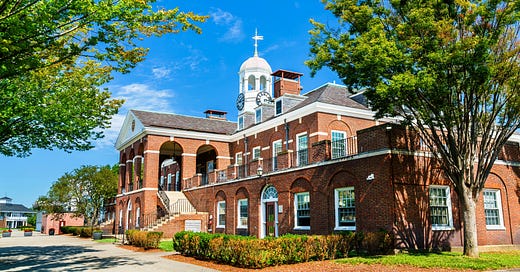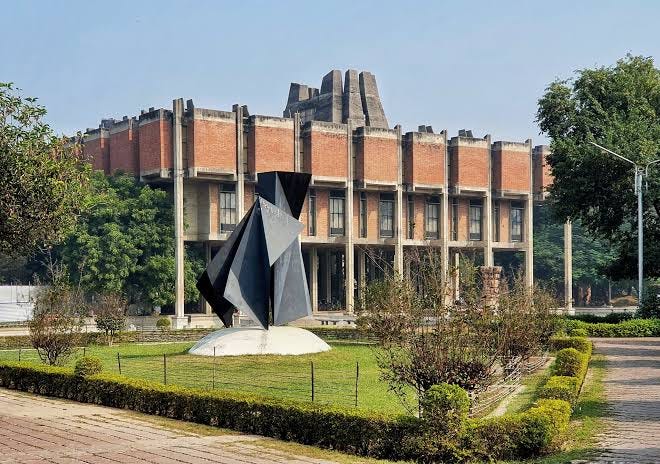#119 - Notes on Harvard University and IIT's
Education Coffee is 2xWeekly Newsletter on People, Ideas and Culture
I have always been curious about the idea of a university. Here is a detailed breakdown of the history of two top institutions around the world and how they became spaces to promote learning, teaching and innovation
What is the history of Harvard University in the US?
Harvard University, the oldest institution of higher education in the United States, was established in 1636 in Cambridge, Massachusetts.
Here’s an overview of its history, highlighting key dates and figures:
Founding and Early Years
1636: Harvard College was established by a vote of the Great and General Court of the Massachusetts Bay Colony to provide higher education in the New World.
1638: The college acquired its first piece of land in Cambridge and a library collection.
1639: The school was named Harvard College in honor of John Harvard, a young clergyman who bequeathed his library and half of his estate to the institution upon his death.
Leadership and Growth
1642: The first Harvard commencement ceremony took place, with nine graduates.
1708–1724: Under John Leverett, the college expanded its curriculum and established itself as a leading institution.
1806: John Quincy Adams, future U.S. president, graduated from Harvard.
1869–1909: Under the presidency of Charles William Eliot, Harvard underwent major transformations. Eliot introduced the elective system, broadened the curriculum, and laid the foundations for the modern research university.
Expansion and Professional Schools
1817: The Harvard Law School was founded, becoming one of the first professional law schools in the U.S.
1847: The Harvard Medical School relocated to Boston, where it remains today.
1879: The Radcliffe College was established as an institution for women, closely affiliated with Harvard (later merged in 1999).
1900: Harvard was a founding member of the Association of American Universities.
20th and 21st Century Developments
1936: Harvard celebrated its 300th anniversary.
1943: The institution contributed significantly to World War II efforts, including radar development.
1969: Harvard began admitting women undergraduates to its classes in partnership with Radcliffe College.
2007: Drew Gilpin Faust became Harvard’s first female president.
2021: Claudine Gay was announced as the next president, set to assume office in 2023.
Notable Figures
Harvard has educated numerous influential leaders, scholars, and professionals, including:
John Adams, Theodore Roosevelt, and Barack Obama: U.S. presidents.
Ralph Waldo Emerson: Philosopher and poet.
Helen Keller: Advocate and author (attended Radcliffe, associated with Harvard).
E.O. Wilson: Pioneering biologist.
Harvard’s legacy is defined by its contributions to education, research, and global leadership, maintaining its reputation as one of the world’s premier academic institutions.
What is special about an education at Harvard University?
World-Class Faculty
Harvard boasts a roster of distinguished faculty members, including Nobel laureates, Pulitzer Prize winners, and leading scholars across disciplines. Students benefit from direct exposure to top-tier academic expertise and mentorship.Academic Excellence and Flexibility
Diverse Programs: Harvard offers over 3,700 courses across disciplines and 50+ concentrations, allowing students to explore their interests deeply or broadly. Liberal Arts Focus: Undergraduates experience a liberal arts education, emphasizing critical thinking, creativity, and cross-disciplinary learning. Graduate Excellence: Its graduate and professional schools, including Harvard Business School, Harvard Law School, and Harvard Medical School, are among the best in the world.Research Opportunities
Harvard is a global leader in research, with over $1 billion in annual funding.
Students, including undergraduates, are encouraged to engage in cutting-edge research, often collaborating with faculty or pursuing independent projects.
Facilities like the Widener Library, one of the largest academic libraries in the world, and advanced labs support innovation and discovery.Global Network and Prestige
Alumni Network: With over 400,000 alumni worldwide, the Harvard network offers unparalleled professional connections and mentorship opportunities. Reputation: As the oldest university in the U.S. and consistently ranked among the top globally, a Harvard degree carries significant prestige and opens doors in any field.Diverse and Inclusive Community
Students hail from all 50 U.S. states and over 150 countries, creating a vibrant, multicultural environment. Harvard supports diversity through financial aid programs and initiatives fostering equity, such as the Office of Diversity, Inclusion, and Belonging.Financial Aid and Accessibility
Harvard’s robust need-based financial aid ensures affordability. Over 55% of undergraduates receive financial aid, and families earning below $85,000 typically pay nothing for tuition. The university is committed to admitting students regardless of their financial background.Campus and Resources
Facilities: Harvard’s campus features historic architecture, state-of-the-art labs, museums, and art collections, enriching the student experience. Extracurriculars: Over 400 student organizations cater to interests ranging from arts and sports to activism and entrepreneurship. Harvard Square: The surrounding area offers cultural and social opportunities, complementing academic life.Focus on Leadership and Impact
Harvard emphasizes cultivating leaders who make a positive impact on society, guided by its motto, “Veritas” (truth). Programs like the Harvard Innovation Lab and partnerships with global organizations prepare students for meaningful careers.Interdisciplinary Learning and Collaboration
Harvard encourages interdisciplinary approaches to address complex global challenges, enabling students to work across fields like AI, climate science, and public health.
Collaboration with neighboring institutions like MIT enhances academic and research opportunities.
An education at Harvard is not only about academic rigor but also about fostering a mindset of curiosity, leadership, and service, equipping students to excel in diverse fields and make significant contributions to the world.
What is the history of the IIT’s in India?
The Indian Institutes of Technology (IITs) are a network of engineering and technology institutions in India. Established in 1950, they are under the purview of the Ministry of Education of the Indian Government and are governed by the Institutes of Technology Act, 1961.
The history of the Indian Institutes of Technology (IITs) is rooted in post-independence India’s vision of building world-class institutions for technological and industrial growth. Here’s a chronological account:
Pre-Independence Vision (1930s – 1940s)
1938: Sir Ardeshir Dalal, a member of the Viceroy’s Executive Council, proposed a plan to establish higher technical institutions in India.
1946: The Sarkar Committee, led by Nalini Ranjan Sarkar, was tasked to create a blueprint for technical education.
The committee recommended establishing four higher technical institutes modeled on the Massachusetts Institute of Technology (MIT) in the USA.
Post-independence, India’s leaders sought to create institutions that would foster technical expertise to drive industrial and economic development.
Establishment of the First IIT (1950s)
1951: IIT Kharagpur, the first IIT, was inaugurated by Maulana Abul Kalam Azad, India’s first Education Minister, on 18 August 1951.
The campus was set up at Hijli, West Bengal, in a former detention camp used during the British Raj.
Dr. J.C. Ghosh, a renowned chemist and academic, became the first Director.
Expansion of IITs with Foreign Collaboration (1950s–1960s)
1958: IIT Bombay was established with assistance from the Soviet Union.
Homi J. Bhabha, a leading scientist and chairman of the Atomic Energy Commission, played a critical role.
1959:
IIT Madras was set up with technical and financial support from West Germany.
IIT Kanpur was established in collaboration with a consortium of nine US universities under the Kanpur Indo-American Program (KIAP).
1961: IIT Delhi was established with funding and expertise from the British government.
Gulzarilal Nanda, India’s then Minister of Planning, was instrumental in its creation.
1961: The IIT Act was passed by the Indian Parliament, declaring IITs as Institutes of National Importance.
Introduction of Competitive Admissions: The Joint Entrance Examination (JEE) was , becoming one of the most competitive exams worldwide, reflecting the high demand for IIT seats. Academic disciplines were allotted to the students via interviews and counselling sessions held at Kharagpur. The IIT-JEE exam was first conducted in 1961 as Common Entrance Exam (CEE), coinciding with the 1961 IIT Act.
Further Expansion and Recognition (1970s–1990s)
Global Recognition: IITs gained international fame, especially as their graduates achieved success globally, particularly in the fields of technology, business, and academia.
1973: The IIT Council, chaired by the Union Minister of Education, was formed to coordinate the activities of all IITs.
1994: IIT Guwahati, the sixth IIT, was established in Assam.
2001: IIT Roorkee became the seventh IIT after being converted from the University of Roorkee, which was originally founded as Thomason College of Civil Engineering in 1847 during British rule.
21st Century: Large-Scale Expansion (2008–2016)
2008–2009: Eight new IITs were established in Bhubaneswar, Gandhinagar, Hyderabad, Jodhpur, Patna, Ropar, Indore, and Mandi.
2012: IIT (ISM) Dhanbad was converted into an IIT.
2015–2016: Four more IITs were set up in Tirupati, Palakkad, Bhilai, and Goa, followed by IIT Jammu.
Key Figures in IIT History
Nalini Ranjan Sarkar: Chaired the committee that proposed the establishment of IITs.
Maulana Abul Kalam Azad: India’s first Education Minister, who inaugurated IIT Kharagpur.
Dr. J.C. Ghosh: First Director of IIT Kharagpur.
Homi J. Bhabha: Pioneered the establishment of IIT Bombay.
Dr. P.K. Kelkar: The first Director of IIT Kanpur, instrumental in its development.
What is special about an education at the IITs in India?
World-Class Education: IITs provide a rigorous and comprehensive curriculum designed to foster critical thinking, problem-solving, and research skills. Modeled after top global institutions like MIT, IITs emphasize hands-on learning and a strong foundation in science and technology.
Prestigious Reputation: Recognized as “Institutes of National Importance” by the Indian government under the IIT Act (1961), IITs have set the benchmark for technical education in India. Globally, IITs are celebrated for producing top-tier engineers, researchers, and entrepreneurs.
Competitive Selection Process: Admission to IITs is through the Joint Entrance Examination (JEE Advanced), one of the toughest and most competitive exams in the world. Only about 1% of applicants secure admission, making IIT graduates a select group of exceptionally talented individuals.
Cutting-Edge Research and Innovation: IITs are leaders in scientific research and technological advancements, contributing significantly to India’s growth in sectors like aerospace, robotics, renewable energy, and artificial intelligence. Many IITs have research parks and innovation hubs fostering startups and collaborations with industries.
Holistic Development: IITs provide opportunities for students to engage in extracurricular activities, cultural festivals (e.g., Mood Indigo at IIT Bombay, Saarang at IIT Madras), and technical events (e.g., Techfest). They encourage innovation, teamwork, and leadership skills beyond academics.
Contribution to Nation-Building: IITs have played a vital role in shaping India’s technological landscape and fostering self-reliance in critical areas like defense, space exploration (ISRO), and IT. Graduates often lead India’s growth in entrepreneurship and social innovation.
International Collaborations: IITs have partnerships with top universities worldwide, facilitating student exchanges, joint research programs, and exposure to global best practices. Some IITs are ranked among the top institutions in Asia and globally in engineering and technology.
Autonomous and Flexible Structure: IITs operate autonomously, allowing them to innovate and adapt their curriculum and research priorities to meet changing global and national needs.
Focus on Social Impact: IIT graduates and faculty often work on projects that address critical challenges in India, such as affordable healthcare, rural development, and clean energy solutions.
International Collaborations: IITs have partnerships with top universities worldwide, facilitating student exchanges, joint research programs, and exposure to global best practices. Some IITs are ranked among the top institutions in Asia and globally in engineering and technology.
Legacy and Global Alumni Network
IIT graduates have become leaders in various fields, including technology, business, academia, and public service.
Prominent alumni include:
Sundar Pichai (CEO, Alphabet/Google)
Arvind Krishna (CEO, IBM)
Narayana Murthy (Founder, Infosys)
This vast and influential network strengthens IITs’ reputation worldwide.
Today, the IITs are regarded as India’s premier institutions for engineering and technology education. They have played a crucial role in producing global leaders in technology, business, and academia. The IIT system continues to expand, reflecting India’s commitment to excellence in education and innovation.
Abhishek





